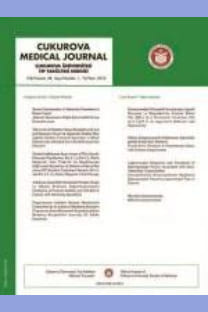Adjuvant uzatılmış temozolamid tedavisinin glioblastoma multiforme hastalarının sağkalımına etkisi
Glioblastoma Multiforme, Radyoterapi, Kemoterapi
Effect of adjuvant extended temozolamide treatment in survival of patients with glioblastoma multiforme
Glioblastoma multiforme, radiotherapy, chemotherapy,
___
- 1. Stupp R, Mason WP, van den Bent MJ, Weller M, Fisher B, Taphoorn MJ et al Radiotherapy plus concomitant and adjuvant temozolomide for glioblastoma. N Engl J Med. 2005;352:987–96.
- 2. Stupp R, Hegi ME, Mason WP, van den Bent MJ, Taphoorn MJ, Janzer RC et al. Effects of radiotherapy with concomitant and adjuvant temozolomide versus radiotherapy alone on survival in glioblastoma in a randomised phase III study: 5-year analysis of the EORTC-NCIC trial. Lancet Oncol. 2009;10:459–66.
- 3. Gilbert MR, Wang M, Aldape KD, Stupp R, Hegi ME, Jaeckle KA, et al. Dose- dense temozolomide for newly diagnosed glioblastoma: a randomized phase III clinical trial. J Clin Oncol. 2013;31:4085-91.
- 4. Roldán Urgoiti GB, Singh AD, Easaw JC. Extended adjuvant temozolomide for treatment of newly diagnosed glioblastoma multiforme. J Neurooncol. 2012;108:173-77.
- 5. Malkoun N, Chargari C, Forest F, Fotso MJ, Cartier L, Auberdiac P, et al. Prolonged temozolomide for treatment of glioblastoma: preliminary clinical results and prognostic value of p53 overexpression. J Neurooncol. 2012;106:127-33.
- 6. Bhandari M, Gandhi AK, Devnani B, Kumar P, Sharma DN, Julka PK. comparative study of adjuvant temozolomide six cycles versus extended 12 cycles in newly diagnosed glioblastoma multiforme. J Clin Diagn Res. 2017;11:XC04-8.
- 7. Stupp R, Dietrich P-Y, Ostermann Kraljevic S, Pica A, Maillard I, Maeder P et al. Promising survival for patients with newly diagnosed glioblastoma multiforme treated with concomitant radiation plus temozolomide followed by adjuvant temozolomide. J Clin Oncol. 2002;20:1375-82.
- 8. Carson KA, Grossman SA, Fisher JD, Shaw EG. Prognostic factors for survival in adult patients with recurrent glioma enrolled onto the new approaches to brain tumor therapy CNS consortium phase I and II clinical trials. J Clin Oncol. 2007;25:2601-6.
- 9. Wu W, Lamborn KR, Buckner JC, Novotny PJ, Chang SM, O’Fallon JR et al. Joint NCCTG and NABTC prognostic factors analysis for high-grade recurrent glioma. Neuro-Oncology. 2010;12:164–72
- 10. Mason WP, Maestro RD, Eisenstat D, Forsyth P, Fulton D, Laperrière N et al. Canadian recommendations for the treatment of glioblastoma multiforme.; Canadian GBM Recommendations Committee.Curr Oncol. 2007;14:110-7.
- 11. Refae AA, Ezzat A, Salem DA, Mahrous M. Protracted adjuvant temozolomide in glioblastoma multiforme. J Cancer Ther. 2015;6:748.
- 12. Hau P, Koch D, Hundsberger T, Marg E, Bauer B, Rudolph R et al. Safety and feasibility of long-term temozolomide treatment in patients with high-grade glioma. Neurology. 2007;68:688-90.
- 13. Barbagallo GMV, Paratore S, Caltabiano R, Palmucci S, Parra HS, Privitera G et al. Long-term therapy with temozolomide is a feasible option for newly diagnosed glioblastoma: a single-institution experience with as many as 101 temozolomide cycles. Neurosurg Focus. 2014;37(6):E4.
- 14. Seiz M, Krafft U, Freyschlag CF, Weiss C, Schmieder K, Lohr F et al. Long- term adjuvant administration of temozolomide in patients with glioblastoma multiforme: experience of a single institution. J Cancer Res Clin Oncol. 2010;136:1691-5.
- ISSN: 2602-3032
- Yayın Aralığı: 4
- Başlangıç: 1976
- Yayıncı: Çukurova Üniversitesi Tıp Fakültesi
Ufuk EMRE, Armağan VAROL, Banu BAYRAMOĞLU
Hüseyin NARCI, Cüneyt AYRIK, Güllü Akbaydoğan DÜNDAR, Evren UYGUNGÜL
Çıkan kolon ve çekumun kistik lenfanjiomu
Abdominal ekstragenital yerleşimli endometriozisler: tek merkez deneyimi
İsmail Cem ERAY, Kıvılcım EREN ERDOĞAN, Orçun YALAV, Uğur TOPAL, Ahmet RENCÜZOĞULLARI, Ahmet Gökhan SARITAŞ, Abdullah ÜLKÜ, Figen DORAN, Atılgan Tolga AKÇAM, Kubilay DALCI
İlaca bağlı diş eti büyümesi: diş hekiminin ikilemi
Arati V Kulkarni, Raghavendra Kini, Prasanna Kumar Rao, Gowri P Bhandarkar, Roopashri Rajesh Kashyap
Tümörü taklit eden bir hepatolitiazis olgusu
Kıvılcım ERDOĞAN, Ahmet Gökhan SARITAŞ, Abdullah ÜLKÜ, Tuğsan BALLI, Atılgan Tolga AKÇAM, Ahmet RENCÜZOĞULLARI, Figen DORAN
Hemiplejik omuzun EMG biofeedback kullanılarak yeniden eğitimi
